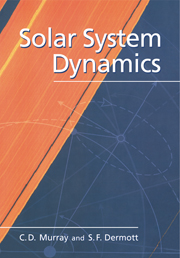Book contents
- Frontmatter
- Contents
- Preface
- 1 Structure of the Solar System
- 2 The Two-Body Problem
- 3 The Restricted Three-Body Problem
- 4 Tides, Rotation, and Shape
- 5 Spin–Orbit Coupling
- 6 The Disturbing Function
- 7 Secular Perturbations
- 8 Resonant Perturbations
- 9 Chaos and Long-Term Evolution
- 10 Planetary Rings
- Appendix A Solar System Data
- Appendix B Expansion of the Disturbing Function
- References
- Index
7 - Secular Perturbations
Published online by Cambridge University Press: 05 June 2012
- Frontmatter
- Contents
- Preface
- 1 Structure of the Solar System
- 2 The Two-Body Problem
- 3 The Restricted Three-Body Problem
- 4 Tides, Rotation, and Shape
- 5 Spin–Orbit Coupling
- 6 The Disturbing Function
- 7 Secular Perturbations
- 8 Resonant Perturbations
- 9 Chaos and Long-Term Evolution
- 10 Planetary Rings
- Appendix A Solar System Data
- Appendix B Expansion of the Disturbing Function
- References
- Index
Summary
Past and to come seem best, things present worst.
William Shakespeare, Henry IV, (2), I, iiiIntroduction
In the last chapter we saw how the disturbing function can be expanded in an infinite series where the individual terms can be classified as secular, resonant, or short period, according to the given physical problem. We have already stated in Sect. 3 that the N-body problem (for N ≥ 3) is nonintegrable. However, in this chapter we will show how, with suitable approximations, it is possible to find an analytical solution to a particular form of the N-body problem that can be applied to the motion of solar system bodies. We can do this by considering the effects of the purely secular terms in the disturbing function for a system of N masses orbiting a central body. The resulting theory can be applied to satellites orbiting a planet, or planets orbiting the Sun, and then used to study the motion of small objects orbiting in either of these systems. This is the subject of secular perturbation theory.
Secular Perturbations for Two Planets
Consider the motion of two planets of mass m1 and m2 moving under their mutual gravitational effects and the attraction of a point-mass central body of mass mc where m1 ≪ mc and m2 ≪ mc. Let R1 and R2 be the disturbing functions describing the perturbations on the orbit of the masses m1 and m2 respectively, where R1 and R2 are functions of the standard osculating orbital elements of both bodies.
- Type
- Chapter
- Information
- Solar System Dynamics , pp. 274 - 320Publisher: Cambridge University PressPrint publication year: 2000

